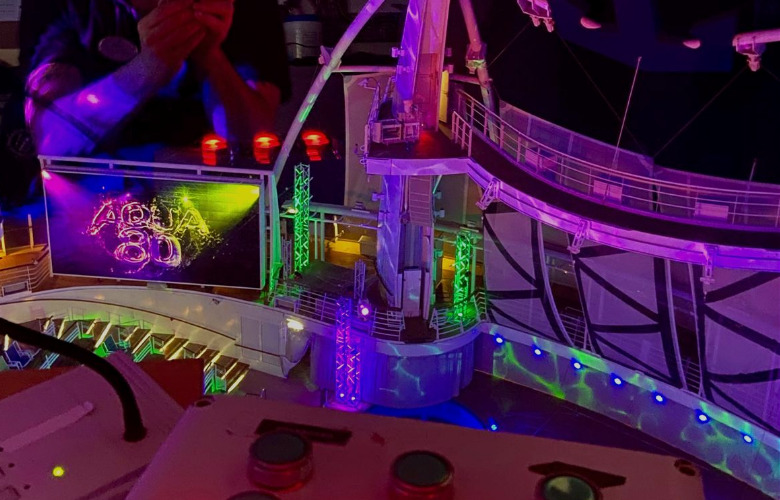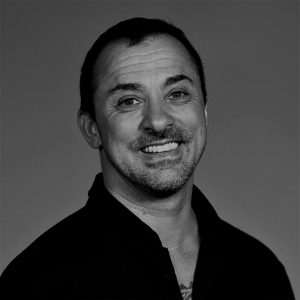
In the fall of 2019, I entered the world of stage management on cruise ships. At that time, I was offered a position as Senior Stage & Production Manager on the Oasis of the Seas. With no regular handover and no handover notes, it took me about a month to get on top of all admin and organizational duties. Thankfully, I had a wonderful cast and crew, who supported and trusted me. Now, to tackle the show call.
In between my intense work schedule, which usually had me up and running at 8 am and falling into bed at 2 am, I tried from day one to find time to practice the show call.
I would get up at 7 am to go through the call once. During the day, I would take any chance to hide in my booth and practice as much as I could before my phone would start ringing again.
The technical director of the ship had been so kind to take over the show call for the first month. This gave me time to first catch up on all my other duties and responsibilities.
I did spend every night in the booth during shows, however. To listen to him, and learn as much from him as I could by looking over his shoulder.
Unfortunately, we did not have time to talk through the show call, to practice together, or to talk through any contingencies and emergency scenarios.
LeRoy was so busy, I was grateful he found enough time to run into the booth (that I had prepared for him) 2 minutes before the show.
As soon as the performance was done, he would jump up and be out the door in a flash to make his rounds through the ship and take care of whatever problems had piled up in the other venues.
Since our show had been produced brand new, nobody had recorded the show call yet. Also, the ship had come straight out of dry dock. Most of our cameras had been uninstalled during the amplification process to protect them. None of the missing ones had been re-installed yet.
The video team onboard was so kind to set up a video camera to film the show for me. LeRoy then embedded the time code into it, so I’d have a video to practice with.
Unfortunately, the video was taken during a night with rough sea conditions. So, the show was modified. Half of our high dives didn’t even take place that night because the ship was moving too much. Also, the video neither showed the entire stage, nor was it in focus.
Six weeks after I arrived onboard, LeRoy and I did a couple runs together in the booth. Due to the blurry video, my timing was a bit off in places. But, otherwise, we were going in the right direction.
Then we tried to set up several tech runs for me to practice. Winter, the Caribbean, and the venue kept forcing us to postpone though.
Each time we had a scheduled tech run, a lift would break. Or we would have a water leak, or the waves would be several meters high.
Cast and crew were starting to joke that I was cursed. But then, finally, after almost two months onboard, we managed to do our tech runs.
I was worried. The conditions of learning this show call had been less than ideal. I had not had the resources I needed.
And I had not been able to be trained by a fellow show caller. Everything LeRoy and I had talked about had been done on the fly, in short moments in between phone calls and emergencies. I knew, there was no way I was fully prepared for calling our show, Aqua80.
I sought the advice of my peers and contacted old friends of mine who had far more show calling experience than I have. One of them eased my mind considerably.
She said, “Liam, even under better conditions, it’s always a process. In the beginning, it won’t always be pretty. But it has to be safe. What do you think, can you call the show safe?” I pondered this for a long moment.
“Yes, I can call it safe. Definitely not pretty yet, but safe.” “Then, you’ll be fine.” She said.
I felt a million times better and ready to go (thank you Anna!!!).
The next few weeks were a sharp learning curve. One difficulty lay in the fact that I always had to do a million things before each show.
Check backstage, check the pool, turn off heat sensors that kept malfunctioning, turn them back on, take multiple phone calls, fix last minute sound and light problems, etc. etc.
Then, as I was trying to relax and focus on the show call ahead (a little guardian angel plush toy in my pocket), I still needed to do multiple phone calls with the bridge, the technical director, the cruise director, and sometimes even the hotel director, who all called to ask how it was going and wanted me to go ahead with the show even though the sea felt quite rough again.
In the end, this decision was up to me, and the Captain and I would do our very best to make the impossible possible.
I don’t know what I would have done without our Captain Goran. He was amazing. He would position the ship just right so we wouldn’t exceed wind speeds. To calm down movement in our theater pool, he would extend stabilizers.
Often, however, this would not be enough. Then he would try all sorts of maneuvers, including slowing down and speeding up, and changing course.
Unfortunately, after three months he left, and his replacement, who was far less cooperative, arrived.
Looking back now, I would say that is one of the major difficulties of managing a venue on a cruise ship. Trust and continuity.
I usually like to work a few years for each show. Especially, if it is a high risk acrobatics and circus show.
This is important and it goes both ways. Of course, there is always a little bit of fluctuation.
But, on a cruise ship, this process of growing together as a team is majorly interrupted by cast and crew (as well as the Captain, the engineers, etc.) constantly being replaced, rotated, and sent to other ships. It is very hard to achieve stability and continuity this way.
All being said, the stage management of the aqua theater on a cruise ship turned out to be one of the most intense learning experiences of my entire life so far.
Looking back now, my time on the Oasis of the Seas was so intense, it was almost surreal. I am astonished and sometimes wonder how I was able to work 12-15 hour days for 5 months straight, without any days off. I am amazed, how I was able to hold it all together, run my venue, keep everyone safe, not miss a beat, and how I just functioned like a little engine that refused to stop running.
Don’t Wear That Hat: Theatre Superstitions & their Origins
Entertainment with A Splash: A History of Aquatic Shows


Liam Klenk was born in Central Europe and has since lived on four continents. Liam has always been engaged in creative pursuits, ranging from photography and graphic design, to writing short stories and poetry, to working in theatre and shows. In 2016, Liam published his first book and memoir, 'Paralian'.
Read Full Profile© 2021 TheatreArtLife. All rights reserved.

Thank you so much for reading, but you have now reached your free article limit for this month.
Our contributors are currently writing more articles for you to enjoy.
To keep reading, all you have to do is become a subscriber and then you can read unlimited articles anytime.
Your investment will help us continue to ignite connections across the globe in live entertainment and build this community for industry professionals.